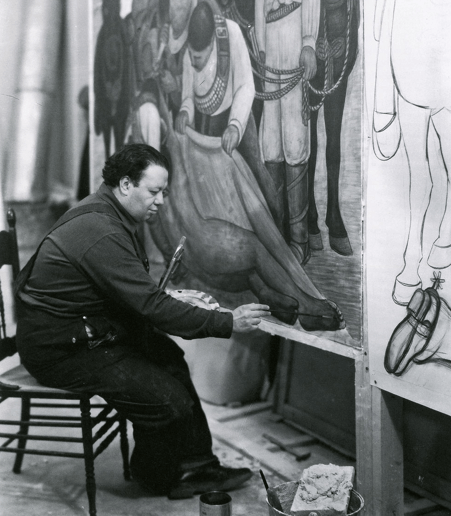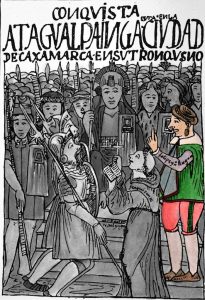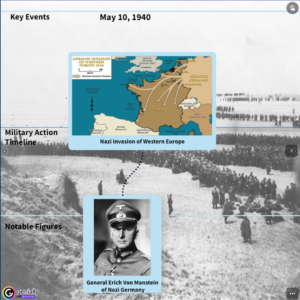Winner of the Spring 2017 StMU History Media Awards for
Best Article in the Category of “Culture”
When entering a Mexican restaurant today, one takes notice of the different aromas, both sweet and savory; one notices the patrons often speaking their language of Spanish; one hears the vibrant tunes of a jukebox; however, one might ask whether the art hanging on the walls of the restaurant isn’t also worthy of the patrons’ attention? One may have seen the famous work of art depicting a woman of colored skin, brown as sugar, contrasting with the white of beautiful calla lilies; or, if not, one might at least be familiar with another work by that same painter.1 The name of this artist, who is known far beyond the Mexican restaurants that hang his famous paintings and murals, is Diego Rivera.

Born in Guanajuato, Mexico, on December 8, 1886, Rivera grew up always seeming to have a hand for creating art. As a child, he had his own studio to work in and later he was granted a scholarship that allowed him to take his talent to Europe, especially to France, where he spent ten years expanding and perfecting his techniques. He is best known for his many influential murals and paintings that illustrate the struggles and lifestyles of the Mexican working class. Among his most famous murals is The History of Mexico from the Conquest to 1930, housed in the National Palace in Mexico City; The Making of a Fresco in San Francisco; and Detroit Industry, located in the city that was home to the American industrial worker in the early twentieth century.2

In the autumn of 1922, Rivera joined the Mexican Communist Party. This organization positively impacted the Mexican community through supporting miners’, factory workers’, and farmers’ rights. With the support of those miners, factory workers, and farmers, Rivera formed the Union of Technical Workers, Painters, and Sculptors. Through the Union, Rivera opened free art schools all over Mexico, through which he was able to spark the Mexican mural movement, enabling his protégés to showcase their art, inspired by Rivera’s own murals. Rivera became well-known in Mexico, and even people from different countries came to his Union to participate.3

In 1929, Rivera began working on a series of frescoes titled History of Mexico from the Conquest to 1930. The art piece took twenty years to complete because of minor adjustments and additions, and he also worked on other pieces in the interim. However, during this time of his busiest artistic activity, he was expelled from the Mexican Communist Party for being “too busy” painting. Despite his expulsion, he continued to favor the working class and always believed he was one of them.4 On February 9, 1934, Nelson Rockefeller was said to have sent workers to destroy a mural located in the Rockefeller Center in New York City, a mural Rivera had spent many weeks painting with smooth precision. The painting was destroyed because of a portrait of Vladimir Lenin painted in the mural, which was not originally in the sketch sent for Rockefeller’s approval. This left Rivera in a state of depression and exhaustion after realizing his hard work was put to waste, without even being given a chance to be named.

Despite the controversies Rivera encountered throughout his career he was still a magnificent painter and influenced much of Mexico’s national art.5 In 1947, another one of Rivera’s murals heated his audience, Dream of a Sunday Afternoon in the Alameda. It was located in the Hotel del Prado across the street from Alameda and the painting covered the history of the park and its peoples (from Rivera’s perspective) all the way from the years of the Spanish Inquisition to the Mexican Revolution. The reason it sparked criticism and caused demonstrators to slash the fresco was because the words “God does not exist” were written in the mural. Rivera, of course, repaired the damages made. In 1956, a year before his death, he announced “I am a Catholic,” and changed the wording on the fresco.6 It was among one of the last great murals he painted. But despite the controversies that Rivera encountered throughout his career, he was still a magnificent painter and influenced much of Mexico’s national art.7

In addition to being a hard worker and a talented painter, Rivera was also great with the ladies. While in Paris he first became engaged to a Russian artist named Angelina Beloff, with whom he had a son, Diego Jr., who unfortunately died at fourteen months from the influenza epidemic of 1919-1920.8 In 1921, he returned to Mexico, where he met a fine beauty from Guadalajara named Lupe Marin. Just a short year later they were married, leaving Angelina in Paris still believing that they were engaged. In the years that followed, Marin bore Diego two daughters, Guadalupe and Ruth.9 However, his infidelity caused their marriage to fall apart, with Marin left raising their daughters on her own. By 1929, Rivera had already remarried, but this time to the famous Frida Kahlo.10

Rivera was working on a painting in the National Palace in Mexico City when Frida approached him; she requested that he get down from the scaffold and give his honest opinion on her own work. After looking at her work, he called it “an unusual energy of expression,” calling her an authentic artist. She invited him to see more of her work at her home in Coyoacán. From there, a friendship blossomed, and soon they fell in love.11 Their marriage was not like any ordinary marriage; it was an emotional roller coaster of a relationship that was well depicted in both of their works, especially in Kahlo’s. She accompanied him everywhere: San Francisco, New York, Detroit, and many other places. They managed for many years, up until Rivera became involved with Frida’s younger sister. They then divorced in 1940.

During this time, Leon Trotsky (Soviet politician) was a target for many agents of Joseph Stalin and was found in his home with a pickaxe jabbed in his head.12 Previously, Rivera and Frida’s home in Coyoacán served as an asylum for Trotsky and his wife as a refuge from these assassins of Stalin’s. While in their home Casa Azul, Kahlo and Trotsky had an amorous affair, and a subsequent quarrel between him and Rivera.13 Rivera cut off any interaction with Trotsky and fled to San Francisco, where he started working on a mural. The police questioned Kahlo about Trotsky’s death, and she later followed Rivera to San Francisco. They remarried that same year, and despite his infidelities, they continued to be passionately in love. However, in 1954, after fourteen more mercurial years of marriage, Kahlo died, and Rivera mourned her death for a year before marrying his third wife, Emma Hurtado. Diego Rivera had a way with women, and his big belly and smelly self did not get in the way of his passion for both art and women.

Rivera was heavily involved in politics at an early stage of his life and continued to be up until his death. In 1955, he was diagnosed with cancer and traveled all the way from Mexico to Moscow to get treatment. Two years later, on November 24th, he passed away in his home in San Angel, Mexico City, Mexico. He wanted his ashes to be spread alongside those of Frida Kahlo in a templo he built; instead, he was buried. Rivera was head of the Anti-Imperialist League and held memberships in the National Peasant League and the Workers’ and Peasants’ Bloc. Also, he rededicated himself to the Mexican Communist Party in 1926 and was a delegate to the Moscow Peasant Congress in 1936.14 Rivera in many ways resembled the indigenous people of the working class illustrated in his works of art. Not only did they share the same native country, but they too were concerned for the political movement and the aftermath of the Mexican Revolution, and they too had the passion and drive to continue working hard, in both sickness and in health.
- Diego Rivera, “Desnudo con Alcatraces,” painting in oil, 1944, original in Private Collection. ↵
- Susan Goldman Rubin, Diego Rivera: An Artist for the People (New York: Abrams Books for Young Readers, 2013), 6. ↵
- Susan Goldman Rubin, Diego Rivera: An Artist for the People (New York: Abrams Books for Young Readers, 2013), 16. ↵
- Susan Goldman Rubin, Diego Rivera: An Artist for the People (New York: Abrams Books for Young Readers, 2013), 22. ↵
- Susan Goldman Rubin, Diego Rivera: An Artist for the People (New York: Abrams Books for Young Readers, 2013), 26. ↵
- William Stockton, “Rivera Mural in Mexico Awaits it New Shelter,” New York Times, January 4, 1987. Accessed April 17, 2017. http://www.nytimes.com/1987/01/04/arts/rivera-mural-in-mexico-awaits-its-new-shelter.html. ↵
- Susan Goldman Rubin, Diego Rivera: An Artist for the People (New York: Abrams Books for Young Readers, 2013), 26. ↵
- Susan Goldman Rubin, Diego Rivera: An Artist for the People (New York: Abrams Books for Young Readers, 2013), 12-13. ↵
- Susan Goldman Rubin, Diego Rivera: An Artist for the People (New York: Abrams Books for Young Readers, 2013), 16-18. ↵
- Frida Kahlo was an iconic revolutionary Mexican artist widely recognized for her disturbing personal self-portraits of the female body and known for her Tehuana style. See Encyclopedia of Activism and Social Justice, 2007, s.v. “Kahlo, Frida (1907–1954),” by Gary L. Anderson and Kathryn G. Herr. ↵
- Susan Goldman Rubin, Diego Rivera: An Artist for the People (New York: Abrams Books for Young Readers, 2013), 18-21. ↵
- Encyclopedia of Activism and Social Justice, 2007, s.v. “Trotsky, Leon (1879–1940),” by Gary L. Anderson and Kathryn G. Herr. ↵
- Encyclopedia of Sex and Gender, 2007, s.v. “Kahlo, Frida (1907–1954),” by Fedwa Malti-Douglas. ↵
- Encyclopedia of Activism and Social Justice, 2007, s.v. “Rivera, Diego (1886–1957),” by Gary L. Anderson and Kathryn G. Herr. ↵



127 comments
Luke Trevino
Wow what a good article!! I had seen Diego Riveras artwork but had never heard him! I have seen several of his paintings in museums as well as restaurants. I find his artwork so beautiful. I like it because I see it a lot around the Hispanic cultural especially around San Antonio! Overall very well researched and written article! Had my attention the whole time I will defiantly recommend this article to someone else!
Mario Sosa
I was unaware just how much of an impact Diego Rivera had on Mexican culture. He must have had a lot of motivation to able to spend twenty years on an art piece. It’s good to hear that Rivera continued painting despite all the criticism that he got. I enjoyed reading the article and liked all the paintings you added, great job!
Aimee Trevino
Again, really well written article! Your opening paragraph gives a great visual to what your story is on, and gives a sense of familiarity, at least for me. These are paintings that are seen repeatedly, and many people are not aware that they were done by Diego Rivera, so this gives a name to the face. Also for this same reason, I really enjoy the use of your images and descriptions.
Alyssa Valdez
I really enjoyed reading your article! I thought everything about it was beautiful! Especially the artwork that you added in! I have never heard of Diego Rivera so I also thought your article was very enjoyable! I can tell you put a lot of time and research in your article. After reading I had to google even more of his artwork and its amazing!
Marissa Gonzalez
I loved how your article was written beautifully; especially with your introduction due to the imagery used regarding Mexican restaurants. Diego Rivera had beautiful artworks that should receive more recognition. I did not know that he had received a scholarship to go to Europe which is impressive. I feel that more credit should have been given to him. One thing that did surprise me was that he was married to Frida Kahlo. I feel that Diego Rivera had an exciting life and you wrote about it in a great way. Good research and well written article!
Mario De Leon
Great article. This article had a lot of information but was well organized. I have had the pleasure of visiting Frida Kahlo’s house/museum in Mexico City and most of my knowledge of Diego Rivera was his time with Frida but this article gave a great description of his life. His murals are amazing and his contribution to Mexican culture and art is remarkable.
Teresa Valdez
The images in this article are beautiful. I love the storytelling element in Rivera’s work. I loved reading about his complete dedication to the arts. Through the opportunities, his influence spread like wildfire. This article clearly portrays the passion that Diego Rivera had in all aspects of his life, whether it be love, politics, or painting. While I knew about his marriage to Frida Kahlo, I was surprised to learn that he had several other marriages and affairs. This article covered so many aspects of Rivera and with a lot of detail. Excellent article!
Alexis Soto
As a Mexican nationalist, I thank you for writing about a famed Mexican artists. As a child I considered myself an artist and relished at every opportunity I had to draw. Because of my love of history I was introduced to works of both Diego and his wife Frida. It wasn’t until later on that I learned of his connections to the Communist party of Mexico and his friendship with Leon Trosky. This was a great article.
Irene Astran
I admire that Diego Rivera never compromised and altered his paintings. I understand why they must have been controversial, but it takes a truly courageous person to stand their ground. It must have been depressing to see a work of art destroyed like the one he had painted in the Rockefeller Center, but nevertheless, he remained true to his vision.
Jennifer Pogue
This is an awesome article! It is very well written and I love the images you used! When I go to Mexican restaurants I love to look at the paintings on the wall. It is sad how many of his works were destroyed. Your article was packed full of facts that were very unique and something I would have never learned if not for this article. Overall great article!